This tactical analysis will provide a scout report on Manchester City player, Lauren Hemp. Using both data & video analysis, the tactics of Manchester City and the roles and responsibilities that Lauren Hemp has within the team will be identified, specifically when Manchester City are in possession of the ball. Positive attributes and contributions of attacking on dribble/running with the ball, crossing and finally the number of touches inside the box will be discussed and analyzed in further detail.
Lauren Hemp is a 19-year-old forward/wide midfielder who joined Manchester City from Bristol City in 2018. During the same year, Hemp was awarded the PFA Women’s Young Player of the Year award. Hemp has represented the England women’s national team, making her debut on 8 October 2019 in a friendly vs. Portugal. She participated in the most recent England squad during the ‘She Believes Cup’, held March 2020, appearing in two games vs. USA and Spain.
Tactical approach of Manchester City WFC
Manchester City are currently in first place of the FAWSL with 40 points, 1 point ahead of second place Chelsea. Formerly coached by Nick Cushing, who left to become the assistant coach of New York City FC in February of 2020, City are currently (as of April 2020) under the stewardship of interim head coach Alan Mahon.
Manchester City have more recently implemented a 1-4-4-2 system (52.9%), with variations including 1-4-4-1-1 (16.8%) and 1-4-1-4-1 (14.5%). City bring a very balanced attack, focusing 32% via the left-hand side, 33% through the centre and 34% on the right.
Due to injuries within the squad, Janine Beckie and Georgia Stanway have been utilized as wide right defenders, moving away from their more familiar roles as wide forward and central attacking midfielder. As a result, Manchester City have recently tactically executed an asymmetrical structure when attacking in the 1-4-4-2 system. This includes positioning Jill Scott, playing at the wide right position within the midfield four, into a more interior channel position, thus allowing Beckie or Stanway space to move higher and into the attacking areas from an initially deeper starting position.
In comparison, Demi Stokes the wide left defender plays a deeper positional role and supports underneath the wide left midfielder, Hemp. An example of this can be seen in the average player position and passing map below which is from the Manchester City vs. West Ham Utd FAWSL fixture. Clearly visible is the high positioning of #11 (Beckie), the interior positioning of #8 (Scott), the deeper role of #3 (Demi Stokes) and finally the high and wide positioning of #15 (Hemp). The tactical implications of this approach aim to bring the best out of each of the Manchester City players, utilizing their individual and collective strengths.

Attacking on the dribble
Lauren Hemp ranks 9th when comparing the average number of dribbles per 90 minutes within the FAWSL (5.21, completing 55%). The player with the highest average number of dribbles per 90 minutes is Chloe Kelly of Everton (8.60, completing 48%). Hemp also is ranked 1st in the average number of progressive runs per 90 (3.39). Wyscout has defined a ‘progressive run’ as one which “moves the ball considerably forward”. Minimal requirements to be classified as a progressive run are 30 meters if starting and finishing in own half, 15 meters if starting in own half and finishing in opponent’s half and finally, 10 meters if starting and finishing in the opponent’s half.
Hemp’s capability to make a high number of progressive runs and dribbles is aided by being able to find space to face forward when receiving possession. She has spatial awareness to be able to both occupy space or if initially marked tightly, create space. This is achieved by a combination of the tactical positional play of Manchester City and her individual movement to lose the direct opponent defending.
Manchester City are tactically set up to create situations in which Hemp will be in possession of the ball with space ahead to either run with the ball into space or with the opposition defender isolated 1v1. This is achieved primarily in two ways. The first is to attack on the right-hand side in order to attract pressure and a high number of the opposition defenders (create attacking underload) to this side of the field. When this occurs, Hemp will remain wide and high on the left-hand side of the field waiting for City to change the angle of attack either via the central defenders Steph Houghton and Gemma Bonner or through the double six pivots of Kiera Walsh and Caroline Weir.
The second tactical approach Manchester City utilize in order to ‘free’ Hemp to receive possession facing forward involves the positioning and movement of left defender, Stokes. Stokes’ starting position when Manchester City are in possession is in a deeper role (compared to the right defender). The movement of Stokes is then dictated by the opposition pressure and how to open the passing line into Hemp.
One option for Stokes is to ‘flatten’ her position (in relation to the CBs Houghton & Bonner) but move slightly infield from the left sideline. This has the impact of drawing the oppositions wide forward/midfielder higher, out of a compact shape, but still maintaining an open passing line/angle from her into Hemp. Stokes can either support underneath if Hemp is attacking 1v1, overlap if Hemp initially is infield or, as in the second diagram below, underlap thus drawing the opposition into vertical space, leaving Hemp with room to drive on the dribble infield and into the half space and central zones.
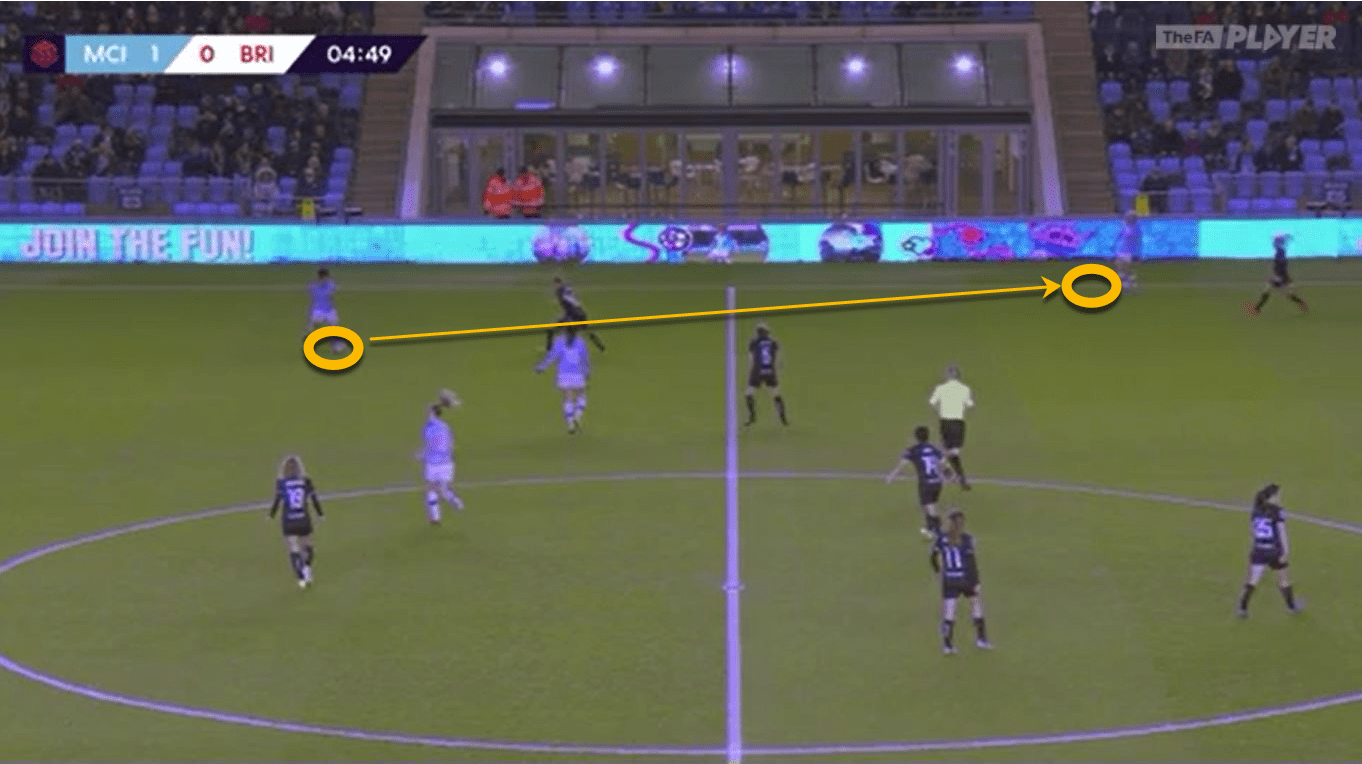
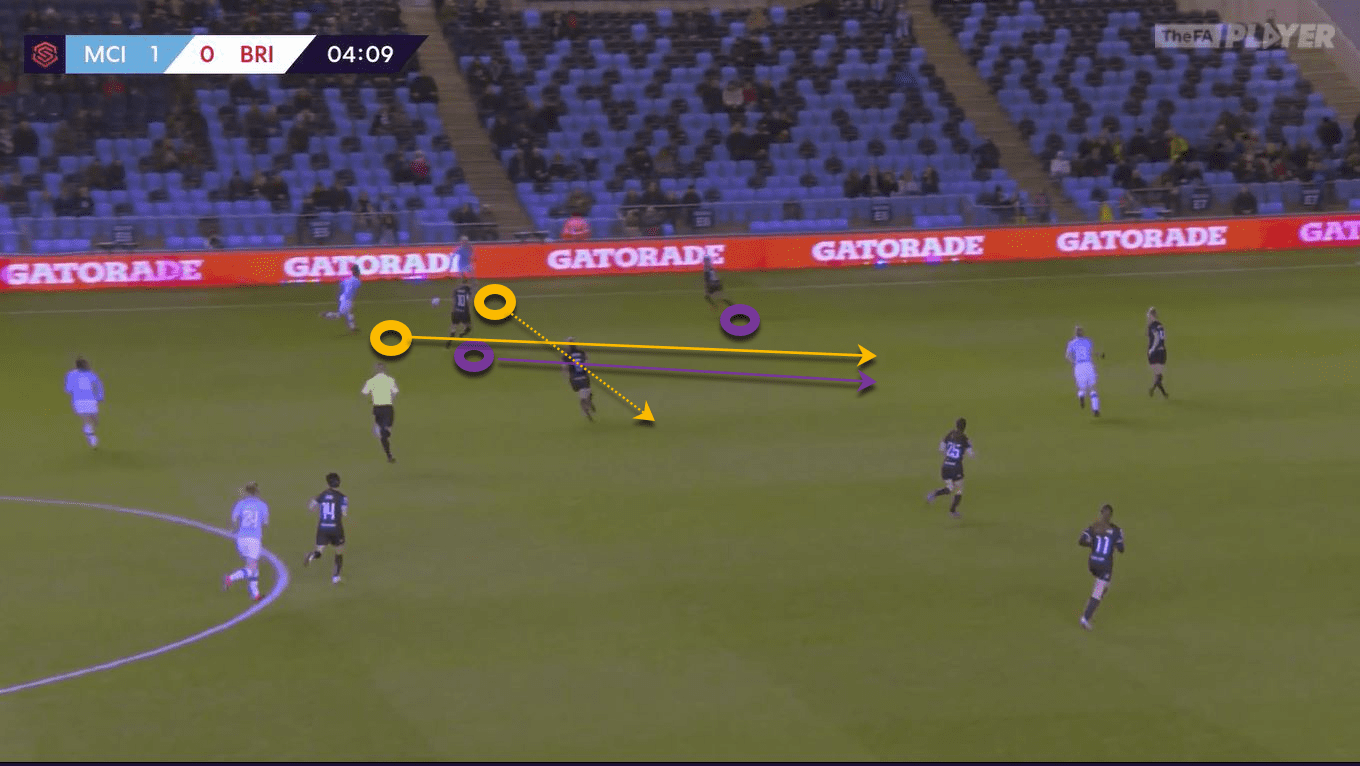
Finally, if the passing lines from central positions into Hemp are closed due to the opposition defensive structures, Stokes will make a diagonal run into the interior/half space channel, ahead of the ball. Stokes can then, if the opponents stays wide be able to receive the ball herself or, if the opponent does follow, space has been created for Hemp to rotate into a deeper and forward-facing position. This movement pattern is shown in the diagram below. Weir is in possession of the ball, Stokes has moved into the interior channel and Hemp, by maintaining width can receive a potential pass in time and space.
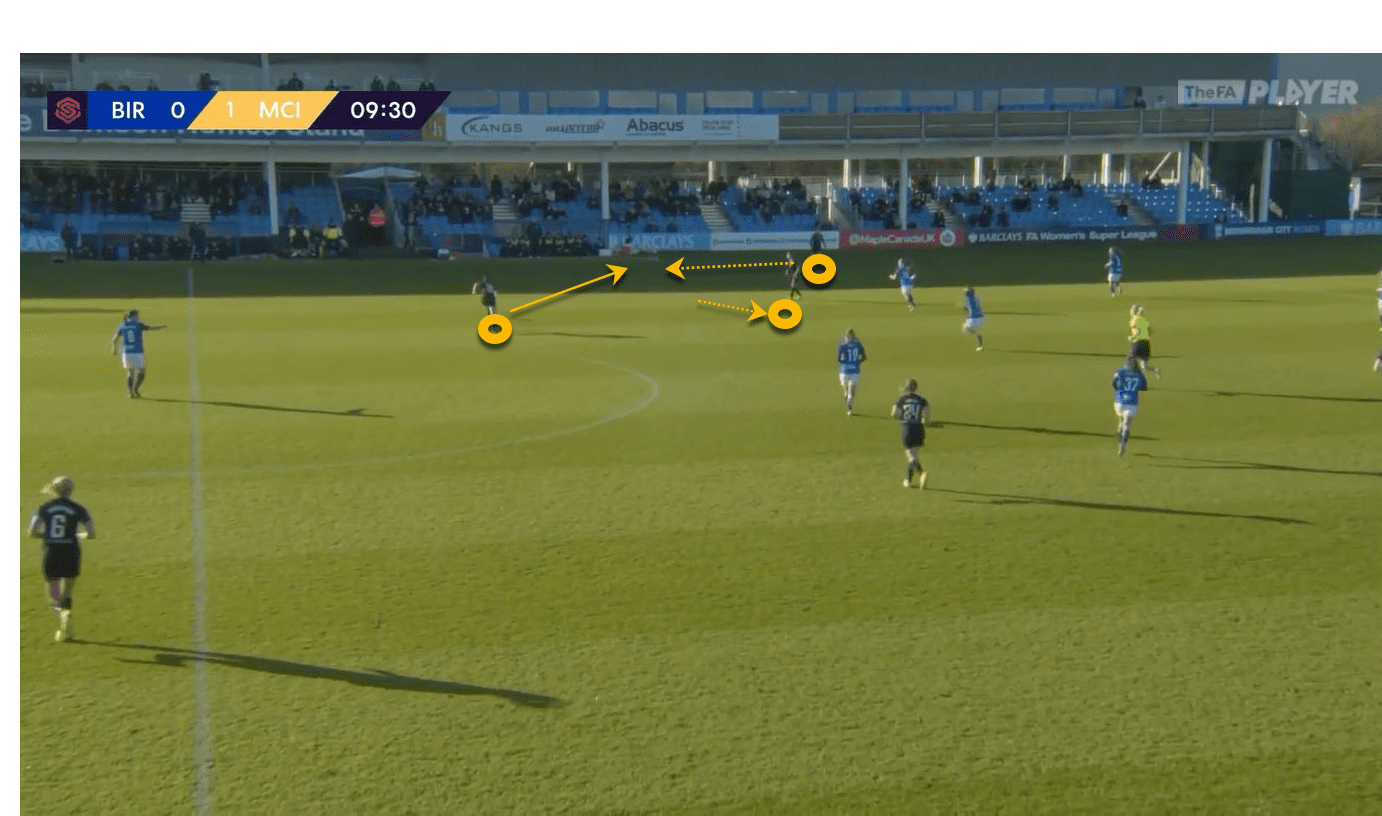
The attacking principles of Manchester City include positional rotations. A specific and regular pattern is for Weir to rotate into the left defender space vacated by Stokes. She is then able to receive possession, unopposed, with time and space to combine/pass into Hemp. The diagram below of Manchester City vs. Bristol City, shows Weir in the left defender position, Stokes higher and infield and Hemp rotating wider and into an open receiving position.
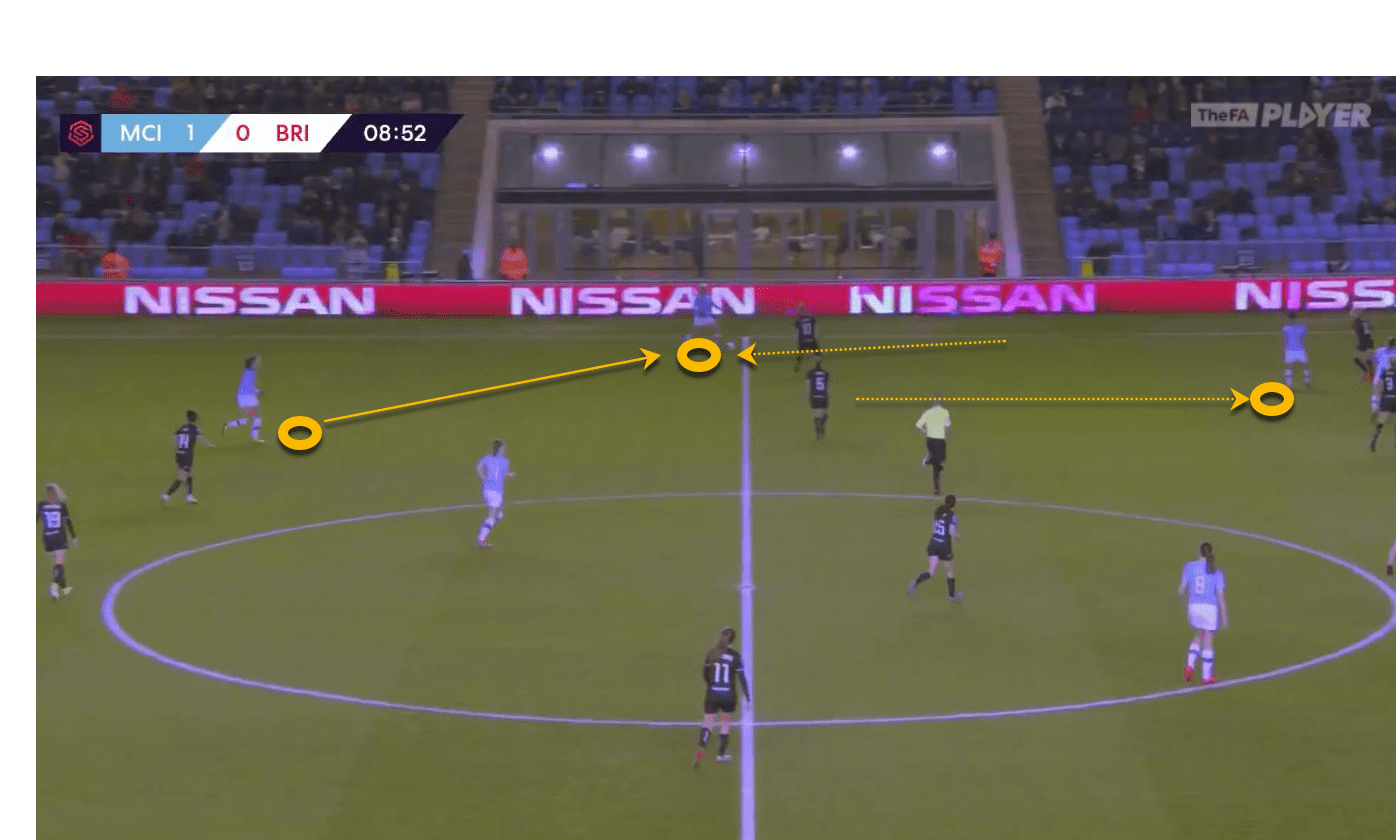
Crossing into the penalty area
Hemp is ranked 9th in average number of crosses per 90 minutes (3.55, completing 34%), within the FAWSL. Compare this to the number one ranked player in the league in terms of the average number of crosses per 90, Beckie (6.59, completing 48%), also of Manchester City. The high amount of crosses Hemp attempts is directly linked to the previous area of discussion regarding the ability of Hemp to receive the ball facing forward as a result of both individual movement and the tactics of Manchester City. By being able to positionally receive the ball facing forward, combined with an attacking & positive mindset, Hemp looks to attack defenders 1v1. This is demonstrated in the diagram below where she has been able to isolate Chelsea right defender, Maren Mjelde. This is an especially a good example of the 1v1 attacking play of Hemp as she has recognized the large amount of space behind Mjelde to attack into and subsequently provide a crossing opportunity.
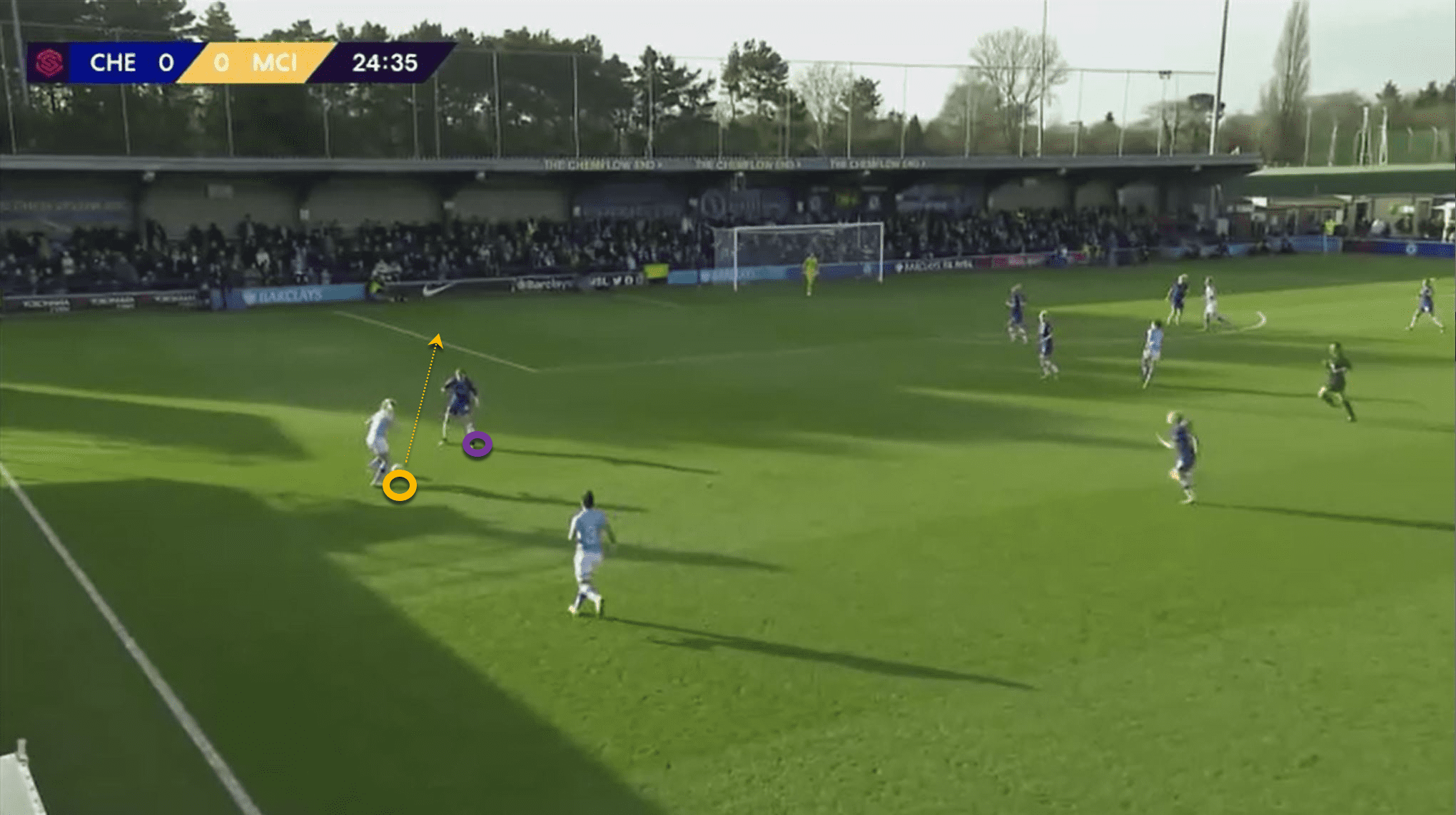
A specific tactical approach that creates situations in which Hemp can be able to cross the ball will now be discussed. This tactical approach by Manchester City is provided by the two central forwards. One of the forwards, will look to receive the ball between the opposition’s midfield and defensive lines. ‘Ideally’ they will have created separation and can receive the ball facing forward. By receiving the ball in this space, pressure is attracted centrally, with the oppositions wide defenders moving into a more compact central shape.
This opens space towards the sideline and for Hemp, who has maintained width and height, to be able to receive forward with the opportunity to cross. In the diagram below, central defender Houghton has played a vertical pass into central forward Tess Wullaert that has eliminated the midfield line of Bristol City. Wullaert, by checking into a deeper position, albeit very slightly deeper, has created space to turn and face forward. This has ‘fixed’ the wide right defender of Bristol City, Faye Brison, and opened space to pass into Lauren Hemp who has positioned herself high and in line with the last line of pressure. The result of this specific action was a cross attempt into the box that Ellen White and Scott were on this occasion unable to convert. In similar situations in which Manchester City play through the central forwards, if the wide defenders remained tight to Hemp, then she can position high and by utilizing her explosive speed, receive a through ball between the right and central defenders.
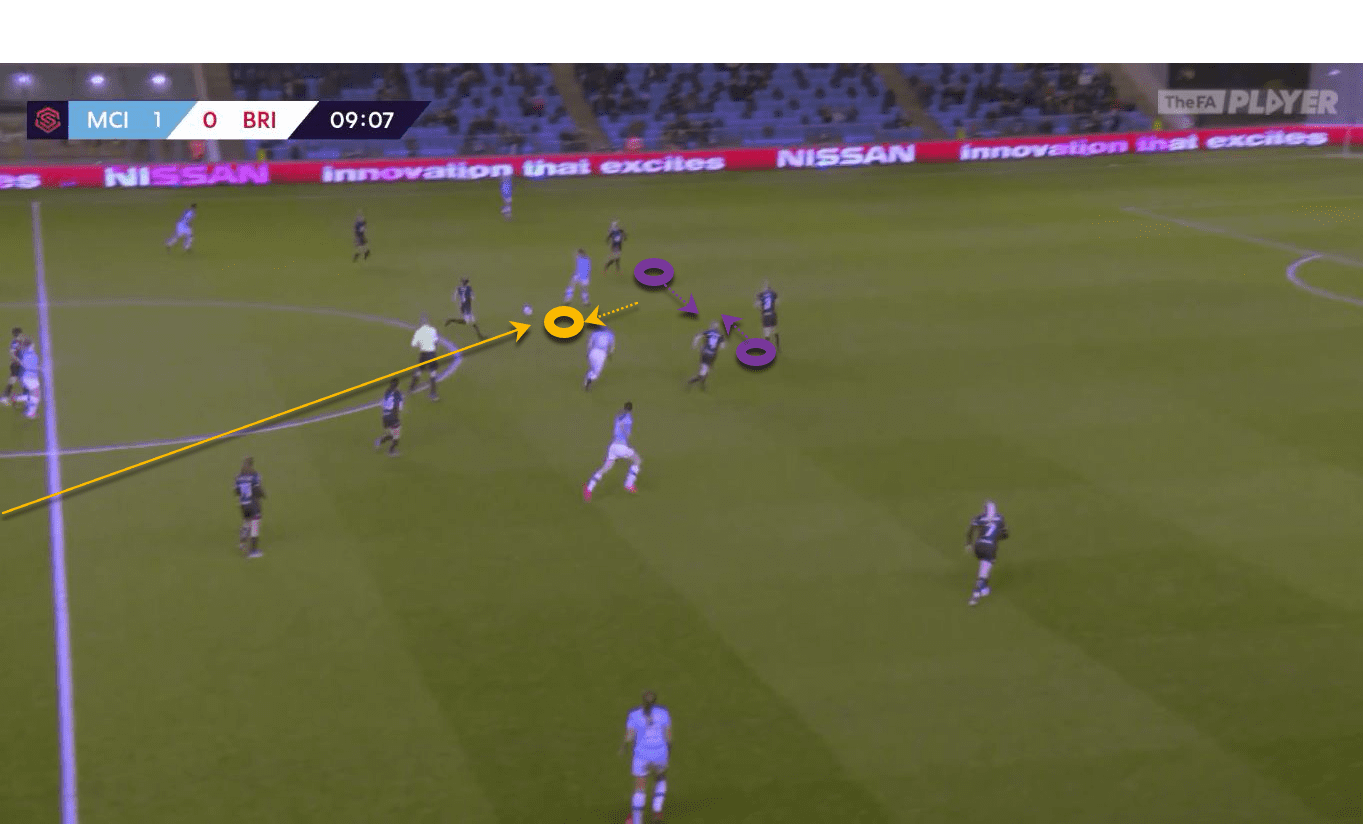
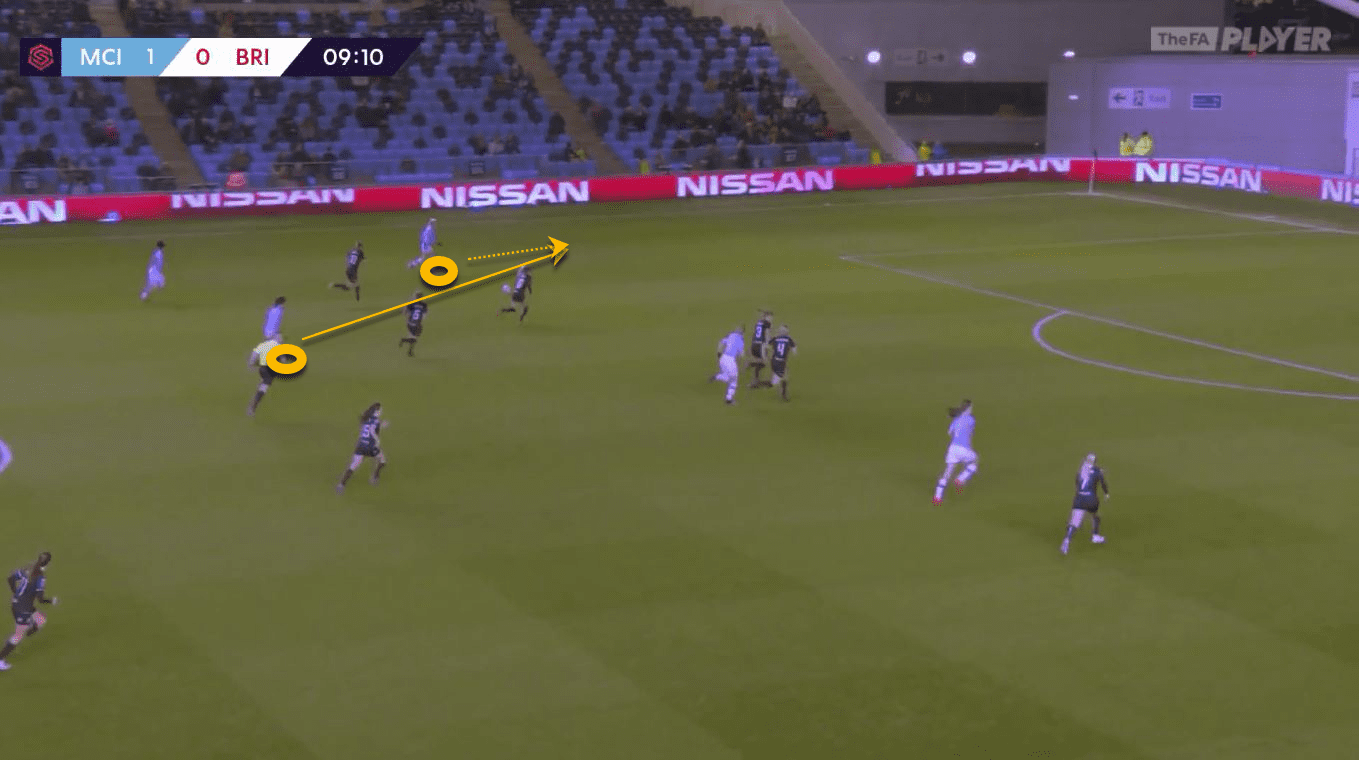
Movement and timing: touches in the box
Hemp currently ranks sixth during the FAWSL 2019/20 season for the number of touches in the box per 90 minutes (4.60). In comparison, the player with the highest number of touches in the box per 90 minutes is Bethany England of Chelsea (6.46).
The high number of touches in the box that Hemp has accumulated during the 2019/20 FAWSL season is a major reason why she has been able to contribute with 5 goals, ranked joint 9th in the league (with 8 other players) and the 3rd highest goal scorer within the Manchester City side.
One of the main tactical reasons for this is the attacking play of Beckie/Stanway, when playing as the right defender and Walsh as the right sided central midfielder producing a high number of crosses. The two examples below are of crosses from the right side. With Manchester City implementing a double central forward line, this occupies the two central defenders. As a result, Hemp is left 1v1 on the far post. Hemp has timed (later/delayed run into the box) and angled (attacking ball between defenders) her run into the penalty area to often arrive unmarked and at the point of ball arrival.
The first diagram is of a goal scored by Hemp vs. Arsenal WFC. The ball was initially won in the middle third by Manchester City who transitioned to attack instantly, Walsh provided an early service with a 3v3 situation inside the penalty area. Hemp makes a positive attacking run between the central defender (#6 Williamson) and the right defender (#20 Maier). After finding this gap and timed her run to coincide with the arrival of the ball, Hemp had an unopposed header on target.
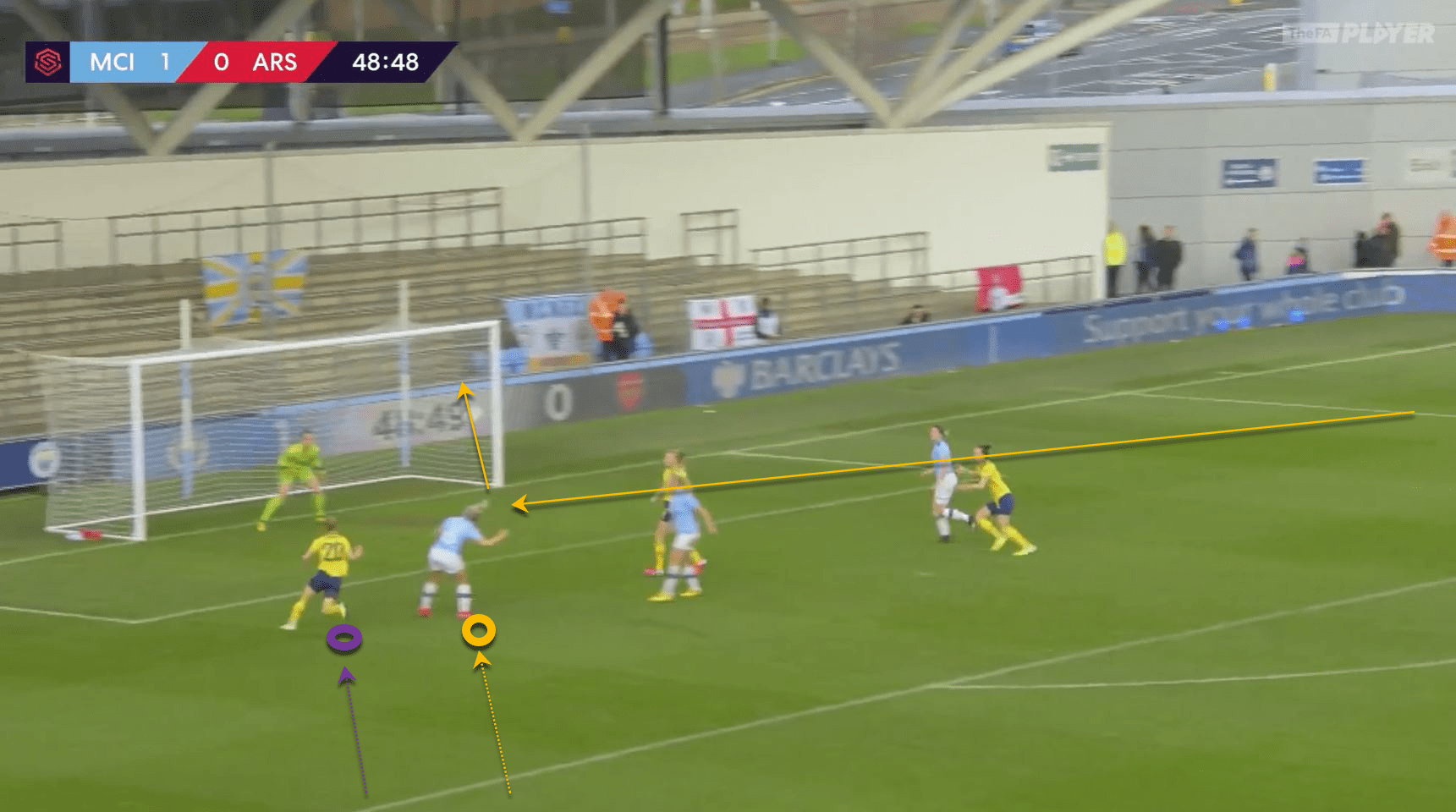
This second example below is of Hemp making a delayed run into the penalty area to attack a cross, although on this occasion Hemp did not score, it again shows the good timing and angle of approach. Beckie initially attacked higher on the right side, drawing the left defender (#25 Jonna Andersson), before passing to the supporting Scott underneath to cross. This type of cross, from a deeper position, draws the CBs, in this example #4 Millie Bright and #16 Magdalena Eriksson towards the near post, again leaving Hemp 1v1 on the far post. On this occasion, Hemp has angled her run on the outside of the right defender.
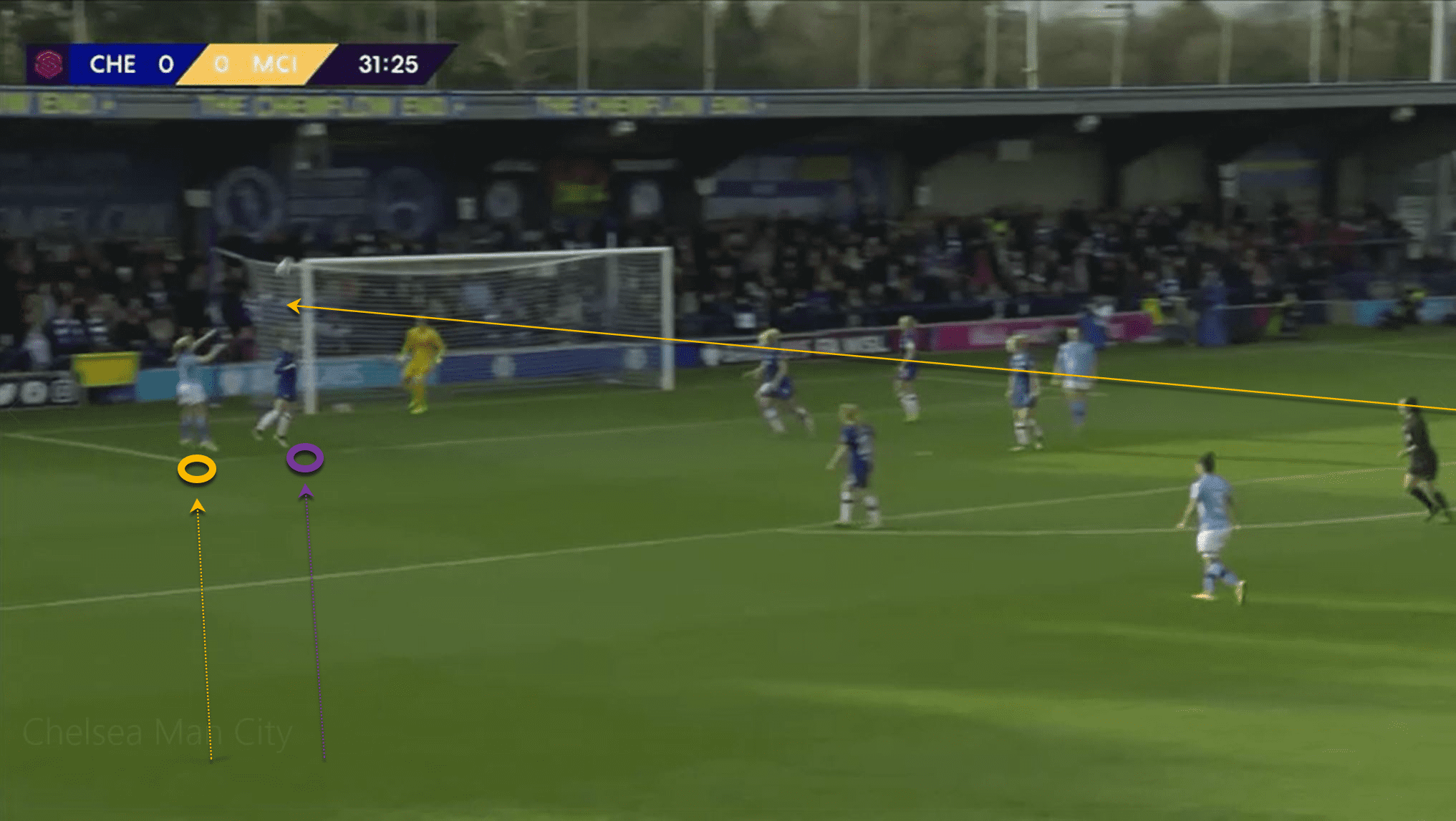
Conclusion
In conclusion to this scout report on Manchester City player Hemp, her ability to make progressive runs, attempt crosses and have a high number of touches inside the penalty area have been identified through a combination of data and video analysis. The ability to perform these actions is related to Hemps individual movement and Manchester Cities tactical approach that enables Hemp to receive the ball facing forward. Hemp can then either run with the ball into space, attack the isolated defender 1v1 or drive on the dribble towards the penalty area after receiving behind the wide defender. These positive traits, combined together, make Hemp a dangerous player, especially within the tactical set up of Manchester City which maximizes her strengths as a player.





Comments